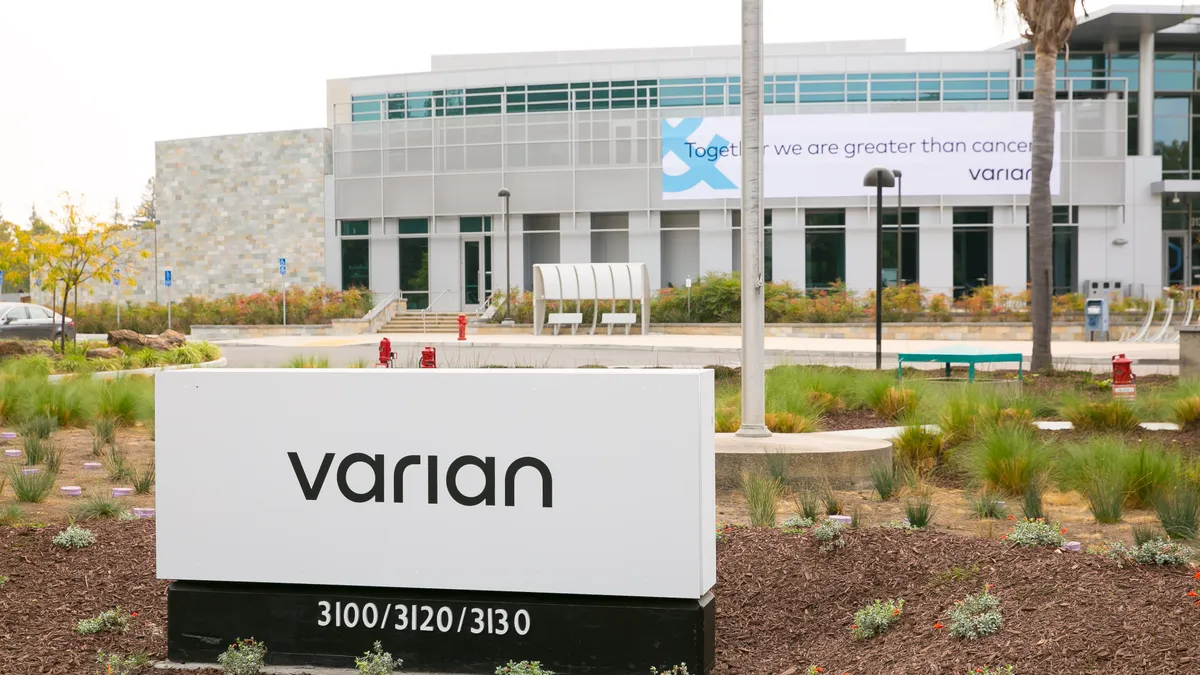Dive Brief:
- Siemens Healthineers is predicting that its $16.4 billion takeover of Varian will drive revenues in the coming years, tipping the acquired unit to post double-digit annual sales growth from 2023 to 2025.
- The forecast underpins Siemens' prediction that sales will rise 6% to 8% annually over those years, up from 5% to 7% in 2022, excluding the impact of COVID-19 antigen tests. Shares in Siemens were up over 5.5% when the market opened Wednesday.
- Siemens also increased its synergy target for the Varian deal from at least €300 million ($340 million) to more than €350 million. The forecast reflects a belief that cross-selling, access to decision-makers and other changes enabled by the merger will benefit Varian.
Dive Insight:
After Siemens closed its takeover of Varian in April, leaders at both businesses sat down to chart out a strategy for the combined company through 2025. The new strategy got its first public airing on Wednesday when Siemens held a capital markets day to discuss what CEO Bernd Montag framed as "a new chapter of accelerated growth."
Siemens' prediction that revenues will grow 6% to 8% a year, and earnings per share will jump 12% to 15% a year, is underpinned by a belief that capabilities in imaging, diagnostics, precision therapy and digital health will equip it to address the biggest opportunities in healthcare.
Varian is critical to the growth forecast, with its 9%-to-12% annual target exceeding the mid-to-high single-digit predictions for the imaging, diagnostics and advanced therapies divisions. Siemens CFO Jochen Schmitz told investors the Varian growth target is based on its "market leadership position in radiation therapy as well as in proton therapy," plus moves into areas such as interventional oncology.
The updated synergy target, which is a split of cost and revenue opportunities, reflects the progress of efforts to combine the companies. Schmitz said all the synergies are now verified and in the execution phase, adding that cost savings from actions such as procurement, back office and infrastructure consolidation will support investment in revenue synergies.
Montag cited Siemens' goal of reducing the initiation of treatment from two weeks to two hours as an example of how it is investing to realize revenue synergies with Varian, explaining that achieving the objective will require "a lot of integration of the imaging and digital capabilities with radiation therapy."
Siemens also discussed its plans for future M&A. Having recently bought Varian, Schmitz said not to expect the company to make another big acquisition in the near term. Siemens does have capacity to do smaller acquisitions in the relatively near term and wants to be in a position to act opportunistically, Schmitz said. The takeover of Varian has slightly shifted the focus of M&A at Siemens.
"The combination with Varian made us a more disease-focused company and made us more relevant. So, looking at technology-enabled therapy certainly is a focus," Montag said. The CEO picked out cardiovascular disease, cancer and neurological disorders as unrealized opportunities that are open to Siemens.
In the near term, Siemens is contending with some of the same macro forces as other medtech companies but it sees opportunities within the challenges. Notably, Montag highlighted healthcare staff shortages in the developing world as a potential driver of interest in Siemens' AI technologies, explaining that the goal is to "take over the routine tasks to make the existing staff more productive."











